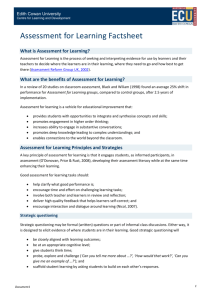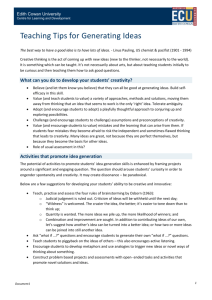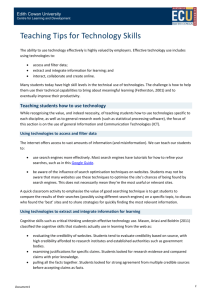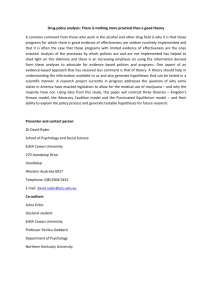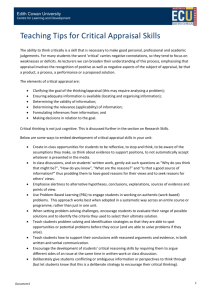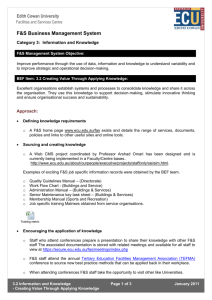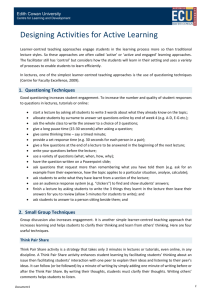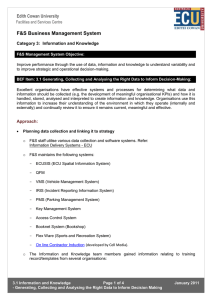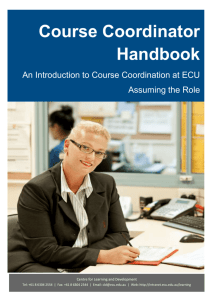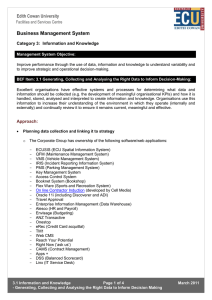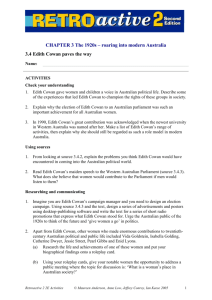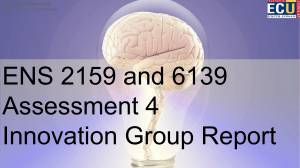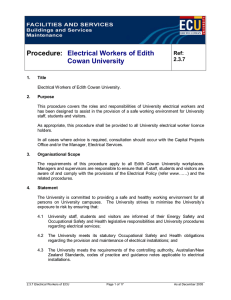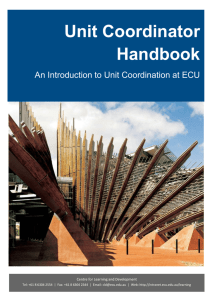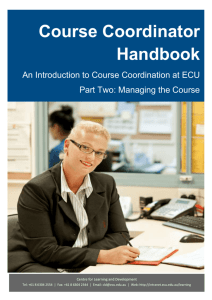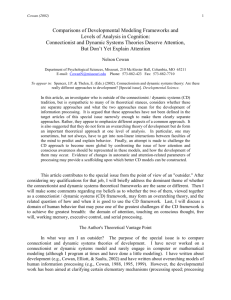Designing a supportive classroom
advertisement
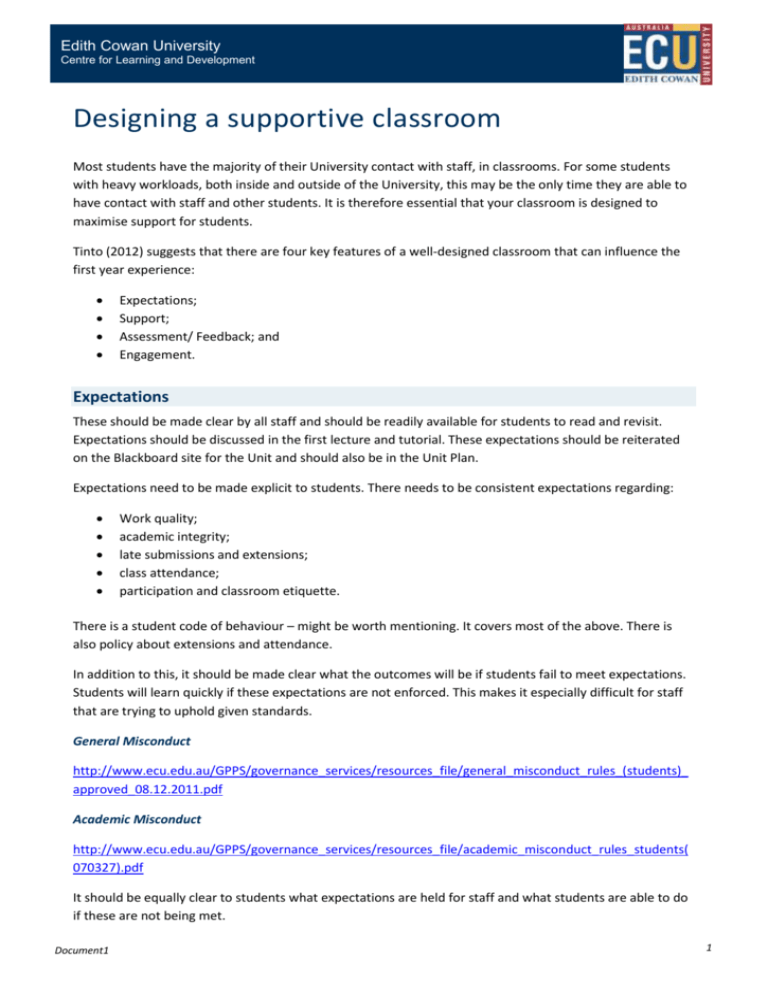
Edith Cowan University Centre for Learning and Development Designing a supportive classroom Most students have the majority of their University contact with staff, in classrooms. For some students with heavy workloads, both inside and outside of the University, this may be the only time they are able to have contact with staff and other students. It is therefore essential that your classroom is designed to maximise support for students. Tinto (2012) suggests that there are four key features of a well-designed classroom that can influence the first year experience: Expectations; Support; Assessment/ Feedback; and Engagement. Expectations These should be made clear by all staff and should be readily available for students to read and revisit. Expectations should be discussed in the first lecture and tutorial. These expectations should be reiterated on the Blackboard site for the Unit and should also be in the Unit Plan. Expectations need to be made explicit to students. There needs to be consistent expectations regarding: Work quality; academic integrity; late submissions and extensions; class attendance; participation and classroom etiquette. There is a student code of behaviour – might be worth mentioning. It covers most of the above. There is also policy about extensions and attendance. In addition to this, it should be made clear what the outcomes will be if students fail to meet expectations. Students will learn quickly if these expectations are not enforced. This makes it especially difficult for staff that are trying to uphold given standards. General Misconduct http://www.ecu.edu.au/GPPS/governance_services/resources_file/general_misconduct_rules_(students)_ approved_08.12.2011.pdf Academic Misconduct http://www.ecu.edu.au/GPPS/governance_services/resources_file/academic_misconduct_rules_students( 070327).pdf It should be equally clear to students what expectations are held for staff and what students are able to do if these are not being met. Document1 1 Edith Cowan University Centre for Learning and Development Academic Support First year students may need more specific academic support to meet the expectations of first year. Tinto suggests that support needs to be contextualised and related back to the classroom so that is has greater meaning for the student. Some ways in which students can be supported are as follows: Questioning Students need to have the opportunity to ask questions about their studies in a non-threatening environment. The physical space of the classroom may feel intimidating, but the virtual space on Blackboard can feel a safer environment for students to ask questions about your unit or the course. A Discussion Board organised for students to ask questions about the university (Where do I go to...? Who can I speak to about...? How do I...?) can ease their uncertainty and allow them to focus their energies on their academic life and can help solve small problems that may seem large. Self-Reflection Providing students with an opportunity to think through (and rethink) some of their previously held attitudes can open the door for discussion about their expectations of university, university staff and their peers. This can create further opportunities to consider whether their attitudes are reasonable and whether their beliefs are useful to their academic achievement. When should they do this? Content heavy units… Learning with peers Providing students the opportunity to work in groups will allow them alternative ways of accessing information. They may feel more comfortable asking questions to their peers, or their peers may have different ways of explaining the same information. It is important to support students in learning how to work well in groups or teams, as not all students will have worked in this type of learning environment before. At ECU there is now some systematic identification of students at risk. Can’t remember what the project is called but will be in effect next year. Engagement Students who are more engaged with their peers, learning and staff are more likely to have a successful university experience. Engaging students can enhance their sense of belonging and increase the likelihood of a positive first year experience. And this is? Peer networks Giving students the chance to work with others in the classroom can allow them to build support networks that can be useful when working on assignments, studying for exams or preparing for workplace experiences. It can be helpful to encourage students to become involved in external activities with other students or meet with students outside of class time. Document1 2 Edith Cowan University Centre for Learning and Development Tutor interaction Getting to know your students and developing a rapport with them will help students feel more supported and engaged with the university. Have students introduce themselves in the first tutorial. Ask questions such as where the student went to high school, what area within the discipline they are most interested in, best memory of school, favourite thing to do outside of study. All of these types of questions will allow students to make a connection- students might discover common interests, common backgrounds, or common purposes. If a student is absent, send a quick email asking if everything is okay. This will let the student know that you notice and are interested in their attendance. Ask students how they are feeling about their first experiences at university. How have they coped finding everything? Is there anything that is still bothering them? It is useful to learn students’ names as quickly as possible. Addressing students by their names demonstrates that you have an interest in them as an individual. Like these. How do we stop everybody doing the same thing in every first tutorial? The following link from Griffith University provides more ideas about how to engage students in first year. http://www.griffith.edu.au/gihe/pdf/gihe_tipsheet_web_ese.pdf Assessment/ Feedback Assessments need to be designed in way that supports students developing an understanding of the content, but also support the development of their academic skills. Some students will not have been in formal schooling for many years and even those that have can easily feel intimidated by the pressures that submitting assignments, particularly the first one, can bring. Good assessment practice suggests that the following can be useful: Low stakes assessment early in semester- this can give students the chance to learn about the mechanics of assignment submission (particularly important with electronic submissions), can provide them with feedback about academic writing skills, or can give students a “feel” for what the unit/ course may be like. Modelling good assessment practice- providing students with exemplars of an assessment will allow them to see what the tutor/lecture is looking for and will give students a guide to the type/ style of writing that is expected at university. Discussing the marking key and providing a marked assignment? Feedback needs to be specific and supportive. It is important that not all elements of a student’s work are overly critiqued. This can be disheartening for students. A few elements should be highlighted for students to work on for the next assessment. This allows students to build up their skills over time. Provide students with a rationale behind the assessment. Students often work better when they understand the purpose behind the task they are being asked to complete. References Tinto, V. (2012). Enhancing student success: Taking the classroom success seriously. The International Journal of First Year Higher Education. 3(1). pp 1-8 Document1 3 Edith Cowan University Centre for Learning and Development Document1 4

